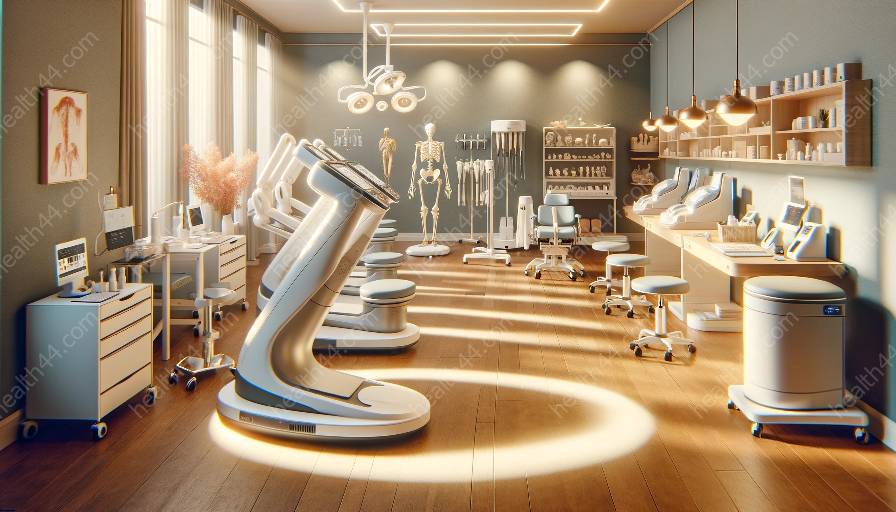Musculoskeletal disorders affect millions of people globally, impacting their mobility and quality of life. To address these challenges, a variety of assistive devices, orthopedic equipment, and medical devices & equipment are available to provide support, improve mobility, and enhance overall well-being. This topic cluster will explore the innovative solutions designed specifically for individuals with musculoskeletal disorders, showcasing the latest advancements in assistive technology.
Understanding Musculoskeletal Disorders
Musculoskeletal disorders encompass a wide range of conditions that affect the body's muscles, bones, joints, ligaments, tendons, and nerves. These disorders can lead to chronic pain, limited mobility, and decreased functional ability, impacting everyday activities and overall independence. Common musculoskeletal disorders include osteoarthritis, rheumatoid arthritis, osteoporosis, back pain, fibromyalgia, and musculoskeletal injuries.
Impact on Daily Life
Individuals living with musculoskeletal disorders often face significant challenges in performing routine tasks, such as walking, standing, grasping objects, and engaging in physical activities. This can lead to decreased independence, reduced social participation, and a lower quality of life. The need for assistive devices and supportive equipment becomes essential in addressing these limitations, enabling individuals to maintain their mobility and function more effectively.
Assistive Devices for Musculoskeletal Disorders
The field of assistive technology offers a diverse range of devices and tools tailored to meet the unique needs of individuals with musculoskeletal disorders. These devices aim to compensate for physical limitations, improve mobility, reduce pain, and enhance overall comfort. Examples of assistive devices include:
- Mobility Aids: Wheelchairs, walkers, canes, and crutches provide stability and support for individuals with mobility impairments, allowing them to move around with greater ease and safety.
- Orthotic Devices: Braces, splints, and supportive garments help stabilize and align joints, providing relief from pain and reducing the risk of injury for those with musculoskeletal conditions.
- Adaptive Tools: Ergonomically designed utensils, dressing aids, and grooming aids assist individuals in performing daily activities independently, compensating for limited hand and arm function.
- Aids for Activities of Daily Living (ADL): Devices such as reachers, grab bars, and modified kitchen equipment enable individuals to carry out essential tasks at home, supporting their independence and comfort.
- Assistive Technology for Work and Recreation: Customized computer interfaces, voice recognition software, and adaptive sports equipment help individuals with musculoskeletal disorders engage in work-related tasks and recreational activities.
Orthopedic Equipment
Orthopedic equipment plays a crucial role in managing musculoskeletal disorders by providing support, stability, and rehabilitation for affected body parts. This specialized equipment is designed to address specific orthopedic conditions and promote healing and recovery. Common types of orthopedic equipment include:
- Braces and Supports: Orthopedic braces and supports are used to immobilize or support injured joints and muscles, aiding in the recovery process and preventing further damage.
- Orthopedic Shoes and Insoles: Footwear with orthotic support and customized insoles provide proper alignment and cushioning, reducing pressure on the feet and improving gait for individuals with musculoskeletal foot conditions.
- Medical Compression Garments: Compression sleeves, socks, and garments help manage swelling, improve circulation, and provide support for individuals with lymphedema or venous insufficiency.
- Traction Equipment: Traction devices are used to gently stretch and decompress the spine or affected joints, providing relief for individuals with musculoskeletal pain and nerve compression.
- Orthopedic Rehabilitation Tools: Exercise balls, resistance bands, and rehabilitation equipment aid in improving strength, flexibility, and range of motion for individuals undergoing orthopedic rehabilitation.
Innovations in Medical Devices & Equipment
The advancements in medical devices and equipment have significantly transformed the landscape of musculoskeletal care, offering innovative solutions for diagnosis, treatment, and rehabilitation. These technologies play a vital role in improving outcomes for individuals with musculoskeletal disorders and enhancing their quality of life. Notable innovations in medical devices & equipment include:
- Minimally Invasive Surgical Tools: Advanced surgical instruments and techniques enable minimally invasive procedures for joint replacements, spinal surgeries, and orthopedic interventions, leading to faster recovery and reduced scarring.
- Implantable Orthopedic Devices: High-quality implants, such as artificial joints, spinal fusion devices, and orthopedic fixation hardware, provide durable solutions for restoring function and stability in musculoskeletal conditions.
- Biomechanical Assessment Systems: Cutting-edge diagnostic tools, gait analysis systems, and motion capture technology help healthcare professionals assess musculoskeletal function, biomechanical performance, and movement patterns with precision.
- Smart Rehabilitation Devices: Wearable sensors, robotic exoskeletons, and virtual reality rehabilitation systems offer personalized and interactive rehabilitation experiences, promoting optimal recovery and functional restoration for individuals with musculoskeletal injuries and disabilities.
- Pain Management Devices: Transcutaneous electrical nerve stimulation (TENS) devices, laser therapy systems, and vibration therapy tools provide non-invasive options for managing pain and promoting tissue healing in musculoskeletal conditions.
Empowering Independence and Well-Being
The integration of assistive devices, orthopedic equipment, and advanced medical devices & equipment plays a pivotal role in empowering individuals with musculoskeletal disorders to lead more independent, active, and fulfilling lives. These innovative solutions not only improve the physical capabilities and functional outcomes of individuals but also enhance their emotional well-being and overall quality of life. By embracing the latest advancements in assistive technology and orthopedic care, individuals with musculoskeletal disorders can experience greater mobility, independence, and comfort, enabling them to thrive in their daily activities and pursuits.


